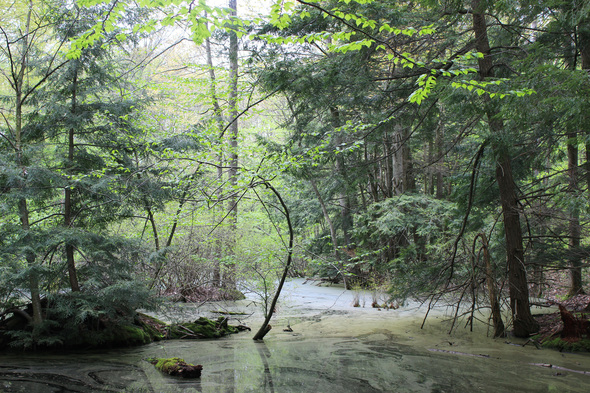In October, the Environmental Protection Agency (EPA) awarded West Michigan Shoreline Regional Development Commission (WMSRDC) a $600,000 grant through the Great Lakes Restoration Initiative.
WMSRDC will partner with its West Michigan Cooperative Invasive Species Management Area (CISMA) partners, which includes Ottawa County Parks, to launch efforts to control and eradicate Hemlock Woolly Adelgid (HWA), a devastating invasive species now established in Michigan that has damaged forests along the east coast over the past decade.
Distribution data from Michigan Departments of Agriculture and Rural Development (MDARD) will be used to begin treatments, but grant funds will be used to survey and record other infestations throughout Lake Michigan’s coastal zone. The project also includes outreach and education for public and private landowners; effective data management; early detection, rapid response and treatment of infested sites.
“The Eastern Hemlock tree plays a crucial role in the forests in Michigan. Hemlock trees are long-lived and provide habitat for a large variety of birds and animals, offering both shelter and forage. The heavy shade given by hemlock trees keep the forest temperatures lower and rivers and streams cooler, which allows for more robust fisheries,” said Kathy Evans an Environmental Program Manager at WMSRDC.
In 2016, eradication efforts led by CISMA and Ottawa County Parks transitioned from a few contained escapes from nursery stock to a more widespread problem. “After speaking with biologists from the east coast, there are many factors that lead us to believe that early efforts can contain the infestation and prevent the major loss of forest, but immediate action must occur if we are to remain optimistic,” said Melanie Manion, Ottawa County Parks.
The effort to slow the spread of the HWA and protect stands of hemlock trees will strengthen Michigan’s natural forest ecosystem. The loss of the hemlock tree would increase the effects of climate change by allowing the forest temperatures to rise, which would be detrimental to wildlife, as well as the beauty of our natural forests. It would also adversely affect the outdoor recreation economy, especially in northern Michigan. Source: MSU Extension
Public outreach and education will be conducted in Oceana, Muskegon, Ottawa, and Allegan Counties in an attempt to obtain information on additional infested trees. New sites that are discovered through outreach efforts will be recorded and inspected. The outreach campaign will also educate the public about the spread of HWA by birds at bird feeders and infested yard waste; best practices will be taught to mitigate these modes of spread.
This grant will allow for the treatment and protection of 65,405 acres of Lake Michigan shoreline and coastal zone from the effects of HWA. It will also help to cover treatment costs for private landowners.
“Funding at this critical point, in which HWA is not yet widespread, is crucial to start the outreach and treatment,” said Evans. “In order to keep management costs low and the possibility of eradication high, the immediate initiation of control efforts is of the utmost importance. We are grateful for the support of the Great Lakes Restoration Initiative to help contain this forest pest before it spreads across the state.”

